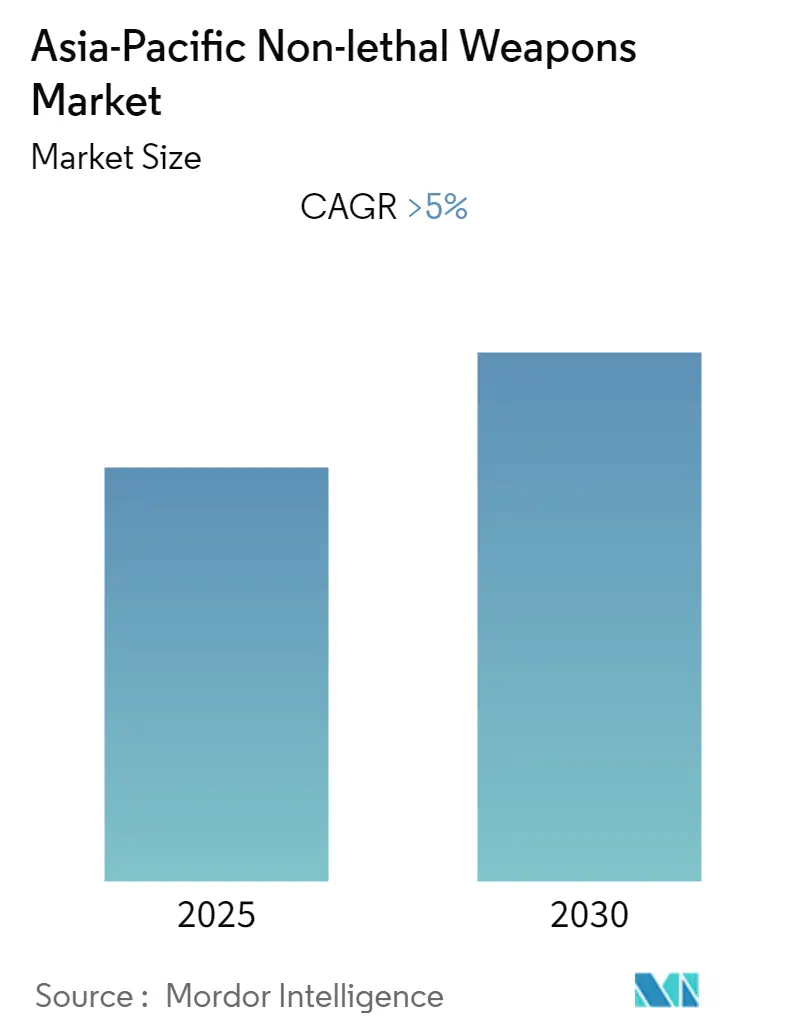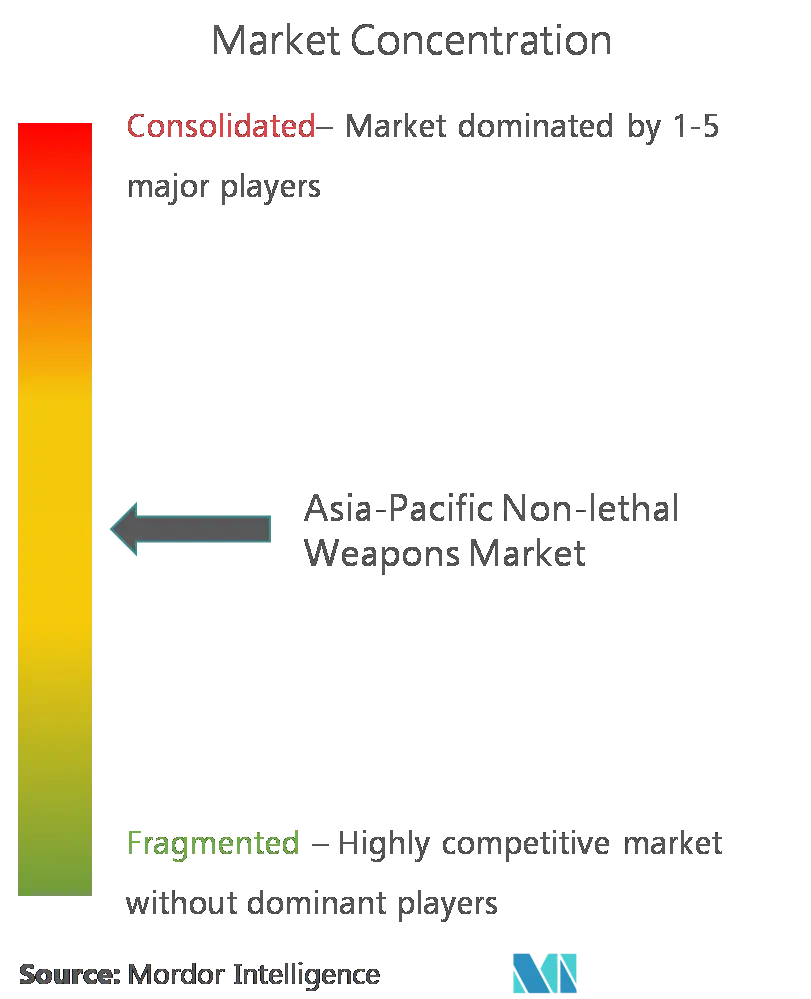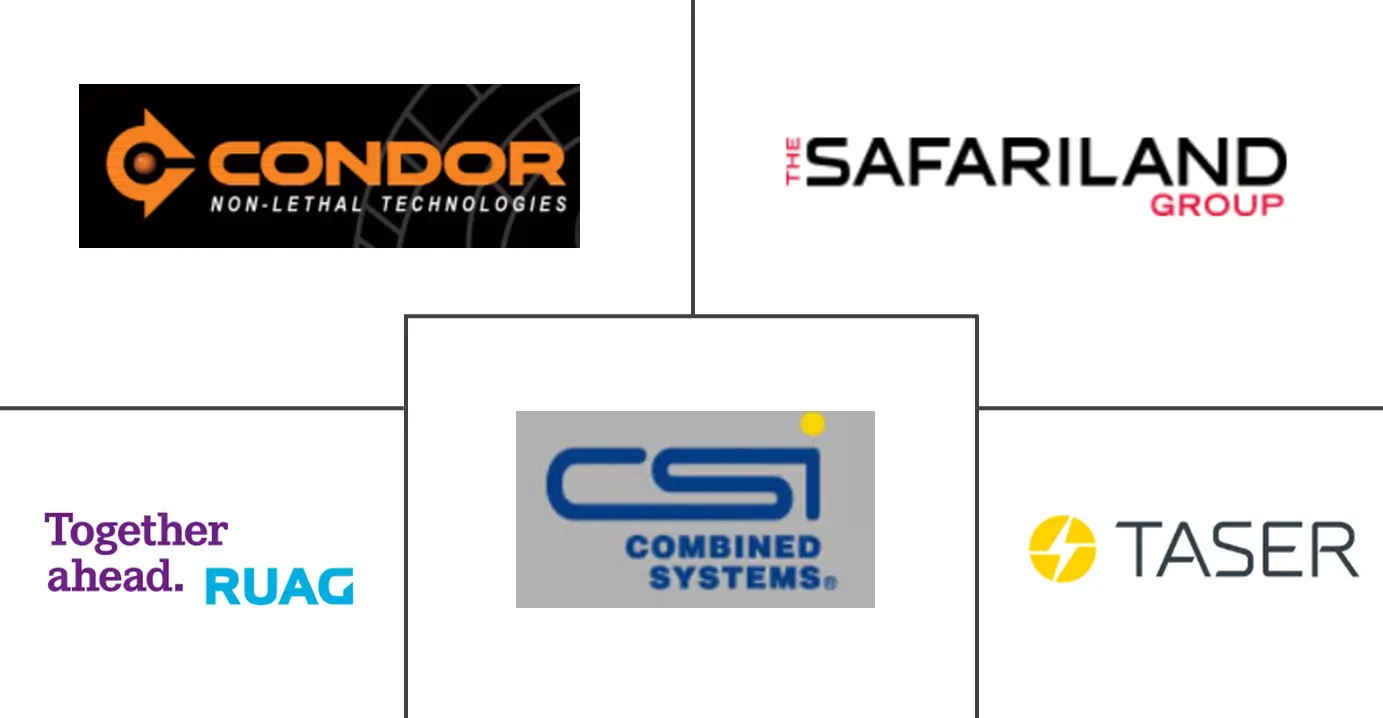
Asia-Pacific Non-lethal Weapons Market Analysis by Mordor Intelligence
The Asia-Pacific Non-lethal Weapons Market is expected to register a CAGR of greater than 5% during the forecast period.
- During the COVID-19 pandemic, the market for non-lethal weapons experienced significant growth due to increased defense and law enforcement expenditures across various countries. In addition, the need to enforce social distancing and lockdown measures has led to the use of non-lethal weapons for crowd control and area restriction.
- India, for example, heavily relied on non-lethal weapons to control the movement of people and prevent the spread of the virus. This contributed significantly to the growth of the market during the pandemic.
- Furthermore, geopolitical tensions in the region have resulted in protests and strikes that have escalated into violent incidents. As a result, law enforcement agencies in countries such as India, China, Japan, and South Korea are procuring non-lethal weapons as a deterrent to protect life and property.
- The market is expected to experience continued growth during the forecast period due to technological advancements made by various players in the region. These advancements are expected to create new opportunities for growth in the non-lethal weapons market.
Asia-Pacific Non-lethal Weapons Market Trends and Insights
Ammunition Segment is Projected to Grow at a High Pace
- The Asia-Pacific non-lethal weapons market is primarily dominated by the ammunition segment, which is expected to continue its dominance in the coming years. One of the primary drivers of this growth is the increasing instances of civilian unrest in the region, which has encouraged law enforcement agencies and the military to procure non-lethal weapons to ensure public safety.
- Moreover, the development of emerging R&D technologies is likely to bolster the development of new non-lethal ammunition, which may further propel the growth of the market. Different types of non-lethal ammunition, such as rubber bullets, wax bullets, plastic bullets, bean bag rounds, and sponge grenades, are used for short-range practice, animal control, and riot control.
- Recent advances in less-lethal technology offer the promise of more effective control over resistive suspects with fewer serious injuries, which may also drive the demand for non-lethal ammunition. For instance, in August 2021, Thai Police used rubber bullets, water cannons, and tear gas against pro-democracy protesters in Bangkok at a rally outside a military barracks housing the prime minister's residence.
- Moreover, governments permit the use of advanced non-lethal weapons in case of emergencies. Hence, the growing requirement for crowd-control weapons may further propel the growth of the market during the forecast period.

China to Dominate the Market During the Forecast Period
- China's dominance in the Asia-Pacific non-lethal weapons market is primarily attributed to the occasional riots and civil unrest, including protests related to labor, environmental, and educational issues in Eastern China's cities. As a result, the country's law enforcement has increasingly resorted to non-lethal ammunition, which collectively has had a positive impact on the market's growth. Furthermore, most police officers in China carry less-lethal weapons like tasers, batons, and mace spray, which are less harmful than traditional firearms. This trend is expected to continue as assaults on law enforcement agencies in the country increase, prompting the government to develop new non-lethal weaponry.
- The rising military spending in China, driven by the country's increasing GDP over the past 15 years, is anticipated to remain the primary factor driving the non-lethal weapons market during the forecast period. This increase in military spending has also led to a growing demand for both lethal and non-lethal weapons.
- The occurrence of riots and civil unrest in Eastern China and Hong Kong has also contributed to the market's growth, with police forces in these cities often resorting to non-lethal ammunition such as plastic and rubber bullets and teargas to control the crowd. For example, during the Hong Kong protests in May 2020, police forces in China used tear gas to disperse the crowd protesting against Beijing's national security law.
- The use of non-lethal weapons across the country is encouraging the development of advanced non-lethal weapons, such as the non-lethal microwave radar weapon that China began developing in September 2019. This weapon shoots microwaves at targets, leaving them in pain under the skin. The development of such advanced non-lethal weapons is anticipated to drive the market further in China during the forecast period.

Competitive Landscape
The Asia-Pacific non-lethal weapons market has several prominent players, including Combined Systems Inc., Condor Non-lethal Technologies, Axon (Taser International Inc.), Safariland LLC, and RUAG Group. These companies have strengthened their market presence through mergers and acquisitions.
Asia-Pacific Non-lethal Weapons Industry Leaders
-
Combined Systems Inc.
-
Condor Non-Lethal Technologies
-
RUAG Group
-
Safariland, LLC
-
Axon (Taser International Inc.)
- *Disclaimer: Major Players sorted in no particular order

Recent Industry Developments
- January 2023: China is providing non-lethal military aid to Russia for Moscow's use in Ukraine. A top-secret intelligence summary stated that Beijing had approved the incremental provision of weapons to Moscow,
- November 2022: China donated two water cannon trucks to the Royal Solomon Islands Police Force (RSIPF), enhancing its reputation as a significant security partner for various countries. These trucks will be used for area control and riot control.
Asia-Pacific Non-lethal Weapons Market Report Scope
A non-lethal weapon is defined as a weapon that can cause pain/irritation to humans in contact with either the skin or any of the human senses without any permanent damage to any of the senses or functions of the human body.
The market study is segmented by type and application. By type, the market is segmented by area denial, ammunition, explosives, gases and sprays, directed energy weapons, and electroshock weapons. By application, the market is segmented by law enforcement and the military. By y Geography into China, Japan, India, South Korea, and the Rest of Asia Pacific.
The report offers market size and forecast in terms of value (USD million) for all the above-mentioned segments.
| Area Denial |
| Ammunition |
| Explosives |
| Gases and Sprays |
| Directed Energy Weapons |
| Electroshock Weapons |
| Law Enforcement |
| Military |
| Asia-Pacific | India |
| China | |
| South Korea | |
| Australia | |
| Japan | |
| Rest of Asia-Pacific |
| Type | Area Denial | |
| Ammunition | ||
| Explosives | ||
| Gases and Sprays | ||
| Directed Energy Weapons | ||
| Electroshock Weapons | ||
| Application | Law Enforcement | |
| Military | ||
| Geography | Asia-Pacific | India |
| China | ||
| South Korea | ||
| Australia | ||
| Japan | ||
| Rest of Asia-Pacific | ||
Key Questions Answered in the Report
What is the current Asia-Pacific Non-lethal Weapons Market size?
The Asia-Pacific Non-lethal Weapons Market is projected to register a CAGR of greater than 5% during the forecast period (2025-2030)
Who are the key players in Asia-Pacific Non-lethal Weapons Market?
Combined Systems Inc., Condor Non-Lethal Technologies, RUAG Group, Safariland, LLC and Axon (Taser International Inc.) are the major companies operating in the Asia-Pacific Non-lethal Weapons Market.
What years does this Asia-Pacific Non-lethal Weapons Market cover?
The report covers the Asia-Pacific Non-lethal Weapons Market historical market size for years: 2020, 2021, 2022, 2023 and 2024. The report also forecasts the Asia-Pacific Non-lethal Weapons Market size for years: 2025, 2026, 2027, 2028, 2029 and 2030.
Page last updated on:
Asia-Pacific Non-lethal Weapons Market Report
Statistics for the 2025 Asia-Pacific Non-lethal Weapons market share, size and revenue growth rate, created by Mordor Intelligence™ Industry Reports. Asia-Pacific Non-lethal Weapons analysis includes a market forecast outlook for 2025 to 2030 and historical overview. Get a sample of this industry analysis as a free report PDF download.



